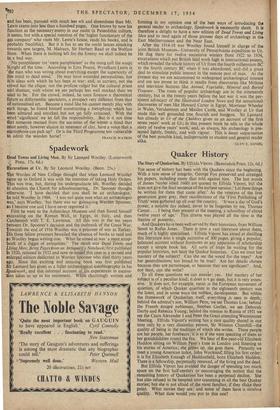Spadework
Dead Towns and Living Men. By Sir Leonard Woolley. (Lutterworth Press. 17s. 6d.)
Fcavations at Ur. By Sir Leonard Woolley. (Benn. 25s.) THE Warden of New College thought that when Leonard Woolley came up to Oxford it was with the intention of taking Holy Orders. This was true, but, during his undergraduate life, Woolley decided tO abandon the Church for schoolmastering, Dr. Spooner thought otherwise. 'I have decided that you shall be an archeologist,' he told Woolley In 1904. '1 was not quite sure what an archeologist was,' says Woolley, ' but there was no gainsaying Warden Spooner, so I became one and I have never regretted it.'
First he went to the Ashmolean Museum and then found himself excavating on the Roman Wall,, in Egypt, in Italy, and then Carchemish with T. E. Lawrence. All this was in the ten years • between Dr. Spooner's decision and the outbreak of the Great War.
Towards the end of 1916 Woolley was a prisoner of war in Turkey. is three fellow prisoners bewailed the absence of books to read and tooWoolley began writing one. What he aimed at was 'a mere scrap- ok of a digger of antiquities.' The result was Dead Towns and to Men; Being Pages from an Antiquary's Notebook, first published 1920, reissued in 1932 and,now re-issued this year in a revised and enlarged edition dedicated to Warden Spooner who died thirty years ego. Since this exciting and amusing book was first published Sir Leonard has given, us a fuller archeological autobiography in his Spadework, and this informal account of his experiences in excava- tion takes us up to his retirement. While charmingly written and forming in my opinion one of the beat ways of introducing the general reader to archeology, Spadework is necessarily short. It Jo therefore a delight to have a new edition of Dead Towns and Living Men and to read again of those pioneer days of archeology in the East Mediterranean and the Near East.
After the 1914-18 war Woolley found himself in charge of the joint British Museum—University of Pennsylvania expedition to Ur. He dug there for twelve successive winters from 1922 to 1934, excavations which put British field work high in international esteem, which revealed the whole history of Ur from the fourth millennium BC to the fourth century BC when it was abandoned, and-did a great deal to stimulate public interest in the remote past of man. At the present day we are accustomed to widespread archeological interest and are too prone to think it results from discoveries like Mithras and television features like Animal, Vegetable, Mineral and Buried Treasure. The roots of popular archeology are in the nineteenth century, but in the twenty years before the last war it was the per- sistent advocacy of the Illustrated London News and the sensational discoveries of men like Howard Carter in Egypt, Mortimer Wheeler in Wales, Verulamium and Maiden Castle, and Woolley at Ur that made this well grounded tree flourish and burgeon. Sir Leonard has already in Ur of the Chaldees given us an account of the first seven years' work at Ur; in this present book he tells us the whole story of twelve years' work, and, as always, his archeology is pre- sented lightly, freshly, and with vigour. This is haute vulgarisation of the best possible kind, indispensable to student and general reader alike.
GLYN E. DANIEL


































 Previous page
Previous page